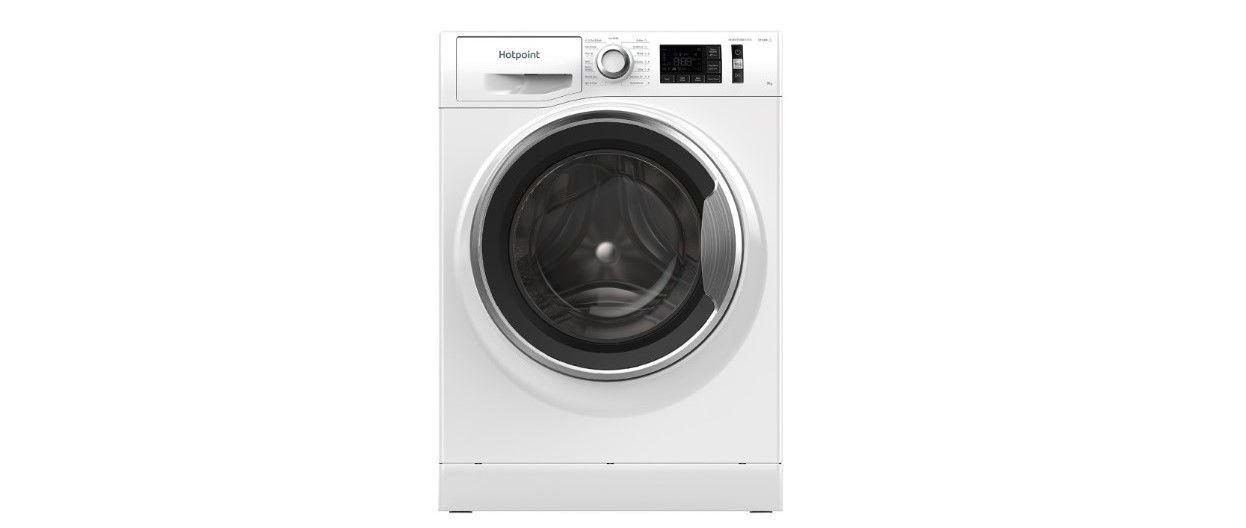Hotpoint Washing Machine
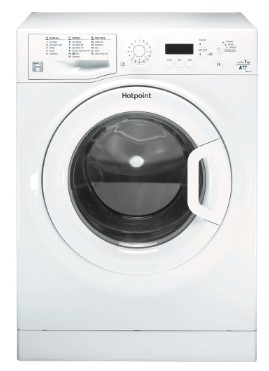
About Hotpoint
Hotpoint adores houses of all shapes and sizes. It’s a place to unwind, have fun, nourish, and raise the family. a setting where you can live your life and express who you are. Simply said, for more than a century, our goal has been to simplify your life at home. Thus, whatever you require For you, Hotpoint has created a product. a line of goods featuring cutting-edge intelligent technology, practical appealing design, and consistently excellent performance.
Because providing excellent customer service is so important to us, we always stay in touch with our clients. We accomplish this through our excellent customer service, our award-winning logistics staff, and if you ever have an appliance problem, The ‘Hotpoint Electric Heating Company’ was formally established in 1911, and their first significant offering was an iron with a heated tip to assist stiffening shirt collars. We haven’t turned around since then. The first Hotpoint refrigerators, vacuums, washing machines, and much more were introduced in the years that followed.
Installation
This Hotpoint Washing Machine instruction manual should be kept in a safe place for future reference. If the washing machine is sold, transferred, or moved, make sure that the Hotpoint Washing Machine instruction manual remains with the machine so that the new owner is able to familiarise himself/herself with its operation and features. Read these instructions carefully: they contain vital information relating to the safe installation and operation of the appliance.
Unpacking and leveling
Unpacking
- Remove the washing machine from its packaging.
- Make sure that the washing machine has not been damaged during the transportation process. If it has been damaged, contact the retailer and do not proceed any further with the installation process.
- Remove the 4 protective screws (used during transportation) and the rubber hotpoint washer with the corresponding spacer, located on the rear part of the appliance (see figure).

- Close off the holes using the plastic plugs provided
- Keep all the parts in a safe place: you will need them again if the washing machine needs to be moved to another location.
Packaging materials should not be used as toys for children.
Leveling
- Install the washing machine on a flat sturdy floor, without resting it up against walls, furniture cabinets, or anything else.
- If the floor is not perfectly level, compensate for any unevenness by tightening or loosening the adjustable front feet (see figure); the angle of inclination, measured in relation to the worktop, must not exceed 2°.
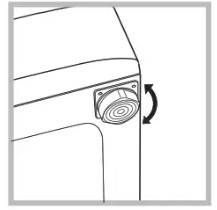
Leveling the machine correctly will provide it with stability, help to avoid vibrations and excessive noise, and prevent it from shifting while t is operating. If it is placed on a carpet or a rug, adjust the feet in such a way as to allow sufficient ventilation space underneath the washing machine.
Connecting the electricity and water supplies
Connecting the water inlet hose
- Connect the supply pipe by screwing it to a cold water tab using a ¾ gas-threaded connection (see figure).
Before performing the connection, allow the water to run freely until it is perfectly clear.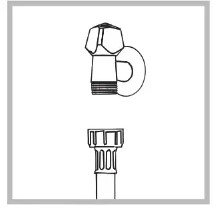
- Connect the inlet hose to the washing machine by screwing it onto the corresponding water inlet of the appliance, which is situated on
the top right-hand side of the rear part of the appliance (see figure).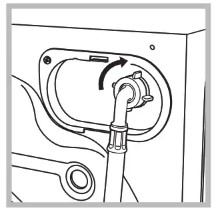
- Make sure that the hose is not folded over or bent.
- The water pressure at the tap must fall within the values indicated in the Technical details table (see next page).
- If the inlet hose is not long enough, contact a specialized shop or an authorized technician.
- Never use second-hand hoses.
- Use the ones supplied with the machine.
Connecting the drain hose
Connect the drain hose, without bending it, to a drainage cut or wall drain located at a height between 65 and 100 cm from the floor;
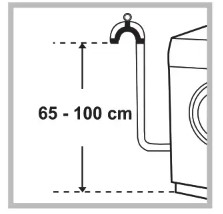
Hotpoint Washing Machine
alternatively, rest it on the side of a washbasin or bathtub, fastening the duct supplied to the tap (see figure). The free end of the hose should not be underwater.
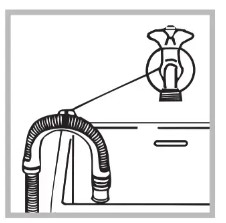
We advise against the use of hose extensions; if it is absolutely necessary, the extension must have the same diameter as the original hose and must not exceed 150 cm in length.
Electrical connections
Before plugging the appliance into the electricity socket, make sure that:
- the socket is earthed and complies with all applicable laws;
- the socket is able to withstand the maximum power load of the appliance as indicated in the Technical data table(see opposite);
- the power supply voltage falls within the values indicated in the Technical data table (see opposite);
- the socket is compatible with the plug of the washing machine. If this is not the case, replace the socket or the plug.
- The washing machine must not be installed outdoors, even in covered areas. It is extremely dangerous to leave the appliance exposed to rain, storms, and other weather conditions.
- When the washing machine has been installed, the electricity socket must be within say reach.
- Do not use extension cords or multiple sockets.
- The cable should not be bent or compressed.
- The power supply cable must only be replaced by authorized technicians.
- Warning! The company shall not be held responsible in the event that these regulations are not respected.
The first wash cycle
Once the appliance has been installed, and before you use it for the first time, run a wash cycle with detergent and no laundry, using wash cycle 2.
| Technical data | |
| Model | ECO9F 1491 |
| Dimensions | width 59.5 cm height 85 cm depth 60 cm |
| Capacity | from 1 to 9 kg |
| Electrical connections | please refer to the technical data plate fixed to the machine |
| Water connections | maximum pressure 1 MPa (10 bar) minimum pressure 0.05 MPa (0.5 bar) drum capacity 62 liters |
| Spin speed | up to 1400 rotations per minute |
| Energy-rated programs according to regulation 60456 | program 6; temperature 60°C; using a load of 9 kg. |
| This appliance conforms to the following EC Directives: – 2004/108/EC (Electromagnetic Compatibility) – 2006/95/EC (Low Voltage) – 2002/96/EC |
|
Description of the washing machine and starting a wash cycle
Control panel

Hotpoint Washing Machine
- Detergent dispenser drawer: used to dispense detergents and washing additives (see “Detergents and laundry”).
- ON/OFF button with indicator light: switches the machine on and off.
If the indicator light is illuminated, this indicates that the machine is switched on. - WASH CYCLE knob: programs the wash cycles. During the wash cycle, the knob does not move.
- SPIN SPEED button: sets the spin speed or excludes the spin cycle completely (see “Personalisation”).
- TEMPERATURE button: sets the temperature or the cold wash cycle (see “Personalisation”).
- DISPLAY: indicates the time remaining for the selected wash cycle and, if a delayed start has been programmed, the time remaining until the start of the wash cycle.
- CONTROL PANEL LOCK button with indicator light: activates or deactivates the control panel lock.
Hotpoint Washing Machine FUNCTION buttons with indicator light: used to select the available functions. The indicator light corresponding to the selected function will remain lit.
WASH CYCLE PROGRESS indicator lights: used to monitor the progress of the wash cycle.
The illuminated indicator light shows which phase is in progress.
DOOR LOCKED indicator light: indicates whether the door may be opened or not (see next page). START/PAUSE button with indicator light: starts or temporarily interrupts the wash cycles.
N.B. To pause the wash cycle in progress, press this button; the corresponding indicator light will flash orange, while the indicator light for the current wash cycle phase will remain lit in a fixed manner. If the DOOR LOCKED the indicator light is switched off, the door may be opened. To start the wash cycle from the point at which it was interrupted, press this button again.
Standby mode
This washing machine, in compliance with new energy-saving regulations, is fitted with an automatic standby system which is enabled after about 30 minutes if no activity is detected.
Press the ON-OFF button briefly and wait for the machine to start up again.
Indicator lights
The indicator lights provide important information.
This is what they can tell you:
Wash cycle phase indicator lights
As the WASH CYCLE knob is rotated, the indicator lights illuminate, indicating the stages which will be performed by the machine in accordance with the selected wash cycle.
Once the desired wash cycle has been selected and has begun, the indicator lights switch on one by one to indicate which phase of the cycle is currently in progress.
- Wash
- Rinse
- Spin
- Drain no spin
- End of the wash cycle
Function buttons and corresponding indicator lights
When a function is selected, the corresponding indicator light will illuminate. If the selected function is not compatible with the programmed wash cycle, the corresponding indicator light will flash, a sound signal will be emitted and the function will not be activated. If a function is incompatible with another function selected previously, only the most recent selection will remain active.
Hotpoint Washing Machine Temperature indicator light
When a temperature value is selected, the corresponding indicator light will illuminate.
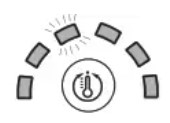
Spin indicator light
When a spin value is selected, the corresponding indicator light will illuminate.
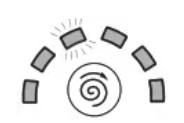
Control panel lock indicator light
To activate the control panel lock, press and hold the button for approximately 2 seconds. When the indicator light is illuminated, the control panel is locked. This means it is possible to prevent wash cycles from being modified accidentally, especially where there are children in the home. To deactivate the control panel lock, press and hold the button for approximately 2 seconds.
Door locked indicator light
If this indicator light is on, the appliance door is locked to prevent it from being opened accidentally; to avoid any damage, wait for the indicator light to switch off before you open the appliance door.
N.B. If the DELAY TIMER function is activated, the door cannot be opened; pause the machine by pressing the START/PAUSE button if you wish to open it. ! If the START/PAUSE indicator light (orange) flashes rapidly at the same time as the function indicator light, this indicates a problem has occurred (see “Troubleshooting”).
Starting a wash cycle
- Turn the washing machine on by pressing the ON/OFF button. All the indicator lights will turn on for a few seconds, then only
the indicator lights relative to the selected program settings will remain lit and the START/PAUSE indicator light will flash. - Load the laundry and close the door.
- Set the WASH CYCLE knob to the desired program.
- Set the washing temperature (see “Personalisation”).
- Set the spin speed (see “Personalisation”).
- Measure out the detergent and washing additives (see “Detergents and laundry”).
- Select the desired functions.
- Start the wash cycle by pressing the START/PAUSE button and the corresponding indicator light will remain lit in a fixed manner, in green.
To cancel the set wash cycle, pause the machine by pressing the START/PAUSE button and select a new cycle. - At the end of the wash cycle, the indicator light will switch on. The DOOR LOCKED indicator light will switch off, indicating that the door may be opened. Take out your laundry and leave the appliance door ajar to make sure the drum dries completely. Switch the washing machine off by pressing the ON/OFF button.
Wash cycles
Table of wash cycles
| Wash cycles | Description of the wash cycle | Max. temp. (t) |
Max. speed (rpm) |
Detergents | Max. load ,, (^g) |
Cycle duration |
|||
| Prewash | Bleach | Wash | Fabric softener |
||||||
| Essentials cycles | The duration of the wash cycles can be checked on the display | ||||||||
| 1 | Cotton + Prewash: extremely soiled whites. | 90° | 1400 | • | • | • | 9 | ||
| 2 | Cotton: heavily soiled whites and resistant colors. | 60° | 1400 | • | • | • | 9 | ||
| 2 | Cotton (2): lightly soiled resistant colors. | 40° | 1400 | • | • | • | 9 | ||
| 3 | Colored cotton (3): lightly soiled whites and delicate colors. | 40° | 1400 | • | • | • | 9 | ||
| 4 | Synthetics: heavily soiled resistant colors. | 60° | 800 | • | • | 4 | |||
| 4 | Synthetics: lightly soiled resistant colors. | 40° | 800 | • | • | 4 | |||
| 5 | Mix 15′: to refresh lightly scaled gatmerits giddy (not suitable for wool, silk and clothes which require washing by hand). |
30 | 800 | – | • | • | 2. | ||
| Special cycles | |||||||||
| 6 | Sanitizing cycle: extremely soiled whites. | 90° | 1400 | – | • | • | • | 9 | |
| 6 | Sanitizing cycle (1): heavily soiled whites and resistant colors . | 60° | 1400 | – | • | • | 9 | ||
| 7 | Goodnight cycle: lightly soiled delicate colours. | 40° | 800 | – | • | • | 4 | ||
| 8 | Shirts | 40° | 600 | – | – | • | • | 2 | |
| 9 | Silk/Curtains: for garments in silk and viscose, lingerie. | 30° | 0 | – | – | • | • | 2 | |
| 10 | Wool: for wool, cashmere, etc. | 40° | 600 | – | – | • | • | 2 | |
| Eco cycles | |||||||||
| 11 | Cotton | Cold Water |
1400 | – | • | • | 9 | ||
| 12 | Synthetics | Cold Water |
800 | – | – | • | • | 3 | |
| 13 | Fast Wash | Colter Water | 800 | – | – | • | • | 3 | |
| Partials cycles | |||||||||
| A | Rinse | – | 1400 | – | – | • | 9 | ||
| B | Spin | – | 1400 | – | – | – | 9 | ||
| C | Pump out | – | 0 | – | – | – | 9 | ||
The information contained in the table is intended as a guide only.
For all Test Institutes
- Test wash cycle in compliance with regulation EN 60456: set wash cycle 6 with a temperature of 60°C.
- Long wash cycle for cotton: set wash cycle 2 with a temperature of 40°C.
- Short wash cycle for cotton: set wash cycle 3 with a temperature of 40°C.
Specials wash cycles
Mix 15’(wash cycle 5) this wash cycle was designed to wash lightly soiled garments quickly: it lasts just 15 minutes and therefore saves both energy and time. By selecting this wash cycle (5 at 30°C), it is possible to wash different fabrics together (except for wool and silk items), with a maximum load of 1.5 kg.
Sanitizing cycle (wash cycle 6). A high-temperature hygienic wash cycle (over 60°C) requires the use of bleach. Pour the bleach, the detergent, and the additives into the relevant compartments (see paragraph entitled “Detergent dispenser drawer”).
Goodnigt cycle (wash cycle 7). This is a silent cycle that can be run at night when the electricity prices are lower. The wash cycle is designed for cotton and synthetics. At the end of the cycle the machine stops while there is still water in the drum; to spin and drain the laundry press the START/PAUSE button; alternatively, the machine will perform the spin cycle and drain the water automatically after 8 hours.
Eco cycles
The Eco Cycles assure energy saving by eliminating the need for heating water and it’s an advantage both to your energy bill and the environment! These innovative Eco programs (Cotton, Synthetics, and Fast Wash ) are available for various fabrics and different quantities of garments; they have been designed to guarantee a high cleaning action even at low temperatures and can be used for lightly to medium soiled loads.
Eco Cycles give the best results thanks to an intensified wash action, and water optimization and are carried out in the same average time of a standard cycle.
For the best washing results with Eco Cycles, we recommend the usage of a liquid detergent.
Hotpoint Washing Machine Personalization
Setting the temperature
Press the TEMPERATURE button to set the wash temperature (see Table of wash cycles). The temperature may be lowered or even set to a cold wash ( ). The washing machine will automatically prevent you from selecting a temperature that is higher than the maximum value set for each wash cycle.
Setting the spin speed
By pressing the SPIN SPEED button to set the spin speed for the selected wash cycle.
The maximum spin speeds available for each wash cycle are as follows:
| Wash cycles Cotton | Maximum spin speed |
| Synthetics | 1400 rpm |
| Wash cycles Cotton | 800 rpm |
| Wool | 600 rpm |
| Silk | drain only |
The spin speed may be lowered, or the spin cycle can be excluded altogether by selecting the symbol.
The washing machine will automatically prevent you from selecting a spin speed that is higher than the maximum speed set for each wash cycle.
Hotpoint Washing Machine Functions
The various wash functions available with this washing machine will help to achieve the desired results, every time.
To activate the functions:
- Press the button corresponding to the desired function;
- the function is enabled when the corresponding indicator light is illuminated.
Note: If the indicator light flashes rapidly, this signals that this particular function may not be selected in conjunction with the selected wash cycle.
Delay timer
To set a delayed start for the selected wash cycle, press the button repeatedly until the desired delay time is displayed (this may be between 1 hour and 24 hours). To disable the function press the button until the text is displayed.
N.B. Once you have pressed the START/PAUSE button, the delay time may only be decreased if you wish to modify it.
! This option is enabled with all programs.
Super Wash
Because a greater quantity of water is used in the initial phase of the cycle, and because of the increased cycle duration, this function offers a high-performance wash.
! This function may not be used in conjunction with wash cycles 5, 6, 9, 10, 11, 12, 13, A, B. C.
Extra rinse
By selecting this function, the efficiency of the rinse is increased and optimal detergent removal is guaranteed. It is particularly useful for sensitive skin. ! This function may not be used in conjunction with wash cycles 5, 13, B. C.
Easy iron
By selecting this function, the wash and spin cycles will be modified in order to reduce the formation of creases. At the end of the cycle the washing machine will perform slow rotations of the drum; the EASY IRON and START/PAUSE indicator lights will flash (orange) and the phase will remain lit in a fixed manner. To end the cycle, press the START/PAUSE button or the EASY IRON button.
For the Silk wash cycle, the machine will end the cycle while the laundry is soaking, the EASY IRON and START/PAUSE indicator lights will flash (orange) and the RINSE phase will remain lit in a fixed manner. To drain the water so that the laundry may be removed, press the START/PAUSE button or the EASY IRON button.
! This function may not be used in conjunction with wash cycles 5, 6, 7, 10, 11, 12, 13, B. C.
Detergents and laundry
Detergent dispenser drawer
Good washing results also depend on the correct dose of detergent: adding too much detergent will not necessarily result in a more efficient wash, and may in fact cause build-up on the inside of your appliance and contribute to environmental pollution.
! Do not use hand washing detergents because these create too much foam.
Open the detergent dispenser drawer and pour in the detergent or washing additive, as follows.
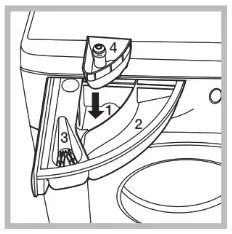
Hotpoint Washing Machine
- compartment 1: Pre-wash detergent (powder) Before pouring in the detergent, make sure that extra compartment 4 has been removed.
- compartment 2: Detergent for the wash cycle (powder or liquid) Liquid detergent should only be poured in immediately prior to the start of the wash cycle.
- compartment 3: Additives (fabric softeners, etc.) The fabric softener should not overflow the grid.
- extra compartment 4: Bleach
Bleach cycle
Bleaching may only be performed in conjunction with wash cycles 2, 3, 6. Pour the bleach into extra compartment 4; pour the detergent and softener into the corresponding compartments, then select one of the abovementioned wash cycles. This option is recommended only for very soiled cotton garments.
Preparing the laundry
- Divide the laundry according to:
- the type of fabric/the symbol on the label.
- the colors: separate colored garments from whites
- Empty all garment pockets and check the buttons.
- Do not exceed the listed values, which refer to the weight of the laundry when dry:
- Durable fabrics: max. 9 kg
- Synthetic fabrics: max. 4 kg
- Delicate fabrics: max. 2 kg
- Wool: max. 2 kg
How much does your laundry weigh?
- 1 sheet 400-500 g
- 1 pillowcase 150-200 g
- 1 tablecloth 400-500 g
- 1 bathrobe 900-1200 g
- 1 towel 150-250 g
Garments requiring special care
- Shirts: use special wash cycle 8 to wash shirts in various fabrics and colors. It guarantees maximum care is taken of the garments and minimizes the formation of creases.
- Silk: use special wash cycle 9 to wash all silk garments. We recommend the use of a special detergent which has been designed to wash delicate clothes.
- Curtains: fold curtains and place them in a pillowcase or mesh bag. Use wash cycle 9.
- Wool: is the only washing machine manufacturer to have been awarded the prestigious Woolmark Platinum Care endorsement (M.0508) by the Woolmark Company, which means that all woolen garments may be washed in the washing machine, even those which state “hand wash only” on the label. Wash cycle 10, therefore, offers complete peace of mind when washing woolen garments in the washing machine (max. load 2 kg) and guarantees optimal performance.
- Load balancing system Before every spin cycle, to avoid excessive vibrations and to distribute the load in a uniform manner, the drum rotates continuously at a speed that is slightly greater than the washing rotation speed. If, after several attempts, the load is not balanced correctly, the machine spins at a reduced spin speed. If the load is excessively unbalanced, the washing machine performs the distribution process instead of spinning. To encourage improved load distribution and balance, we recommend small and large garments are mixed in the load.
Precautions and tips
This washing machine was designed and constructed in accordance with international safety regulations. The following information is provided for safety reasons and must, therefore, be read carefully.
General safety
- This appliance is not intended for use by persons (including children) with reduced physical, sensory, or mental capabilities, or lack of
experience and knowledge unless they have been given supervision or a Hotpoint Washing Machine instruction manual concerning the use of the appliance by a person responsible for their safety. Children should be supervised to ensure that they do not play with the appliance. - This appliance was designed for domestic use only.
- Do not touch the machine when barefoot or with wet or damp hands or feet.
- Do not pull on the power supply cable when unplugging the appliance from the electricity socket. Hold the plug and pull.
- Do not open the detergent dispenser drawer while the machine is in operation.
- Do not touch the drained water as it may reach extremely high temperatures.
- Never force the porthole door. This could damage the safety lock mechanism designed to prevent accidental opening.
- If the appliance breaks down, do not under any circumstances access the internal mechanisms in an attempt to repair it yourself.
- Always keep children well away from the appliance while it is operating.
- The door can become quite hot during the wash cycle.
- If the appliance has to be moved, work in a group of two or three people and handle it with the utmost care. Never try to do this alone, because the appliance is very heavy.
- Before loading laundry into the washing machine, make sure the drum is empty.
Disposal
- Disposing of the packaging materials: observe local regulations so that the packaging may be re-used.
- The European Directive 2002/96/EC on Waste Electrical and Electronic Equipment, requires that old household electrical appliances must not be disposed of in the normal unsorted municipal waste stream. Old appliances must be collected separately in order to optimize the recovery and recycling of the materials they contain and reduce the impact on human health and the environment. The crossed-out “wheeled bin” symbol on the product reminds you of your obligation, that when you dispose of the appliance it must be separately collected.
Consumers should contact their local authority or retailer for information concerning the correct disposal of their old appliances.
Opening the porthole door manually
In the event that it is not possible to open the porthole door due to a power cut, and if you wish to remove the laundry, proceed as follows:
- remove the plug from the electrical socket.
- make sure the water level inside the machine is lower than the door opening; if it is not, remove excess water using the drain hose, collecting it in a bucket as indicated in the figure.
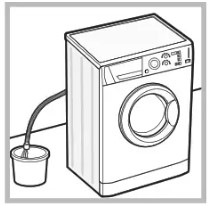
- using a screwdriver, remove the cover panel on the lower front part of the washing machine (see figure).

- pull outwards using the tab as indicated in the figure, until the plastic tie-rod is freed from its stop position; pull downwards and open the door at the same time.
- reposition the panel, making sure the hooks are securely in place before you push it onto the appliance.
Care and maintenance
Cutting off the water and electricity supplies
- Turn off the water tap after every wash cycle. This will limit wear on the hydraulic system inside the washing machine and help to prevent leaks.
- Unplug the washing machine when cleaning it and during all maintenance work.
Cleaning the washing machine
The outer parts and rubber components of the appliance can be cleaned using a soft cloth soaked in lukewarm soapy water. Do not use solvents or abrasives.
Cleaning the detergent dispenser drawer
Remove the dispenser by raising it and pulling it out (see figure). Wash it under running water; this operation should be repeated frequently.
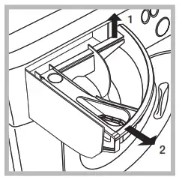
Caring for the door and drum of your appliance
- Always leave the porthole door ajar in order to prevent unpleasant odors from forming.
Cleaning the pump
The washing machine is fitted with a self-cleaning pump which does not require any maintenance. Sometimes, small items (such as coins or buttons) may fall into the pre-chamber which protects the pump, situated in its bottom part.
! Make sure the wash cycle has finished and unplug the appliance.
To access the pre-chamber:
- using a screwdriver, remove the cover panel on the lower front part of the washing machine (see figure);

- unscrew the lid by rotating it anti-clockwise (see figure): a little water may trickle out. This is perfectly normal;
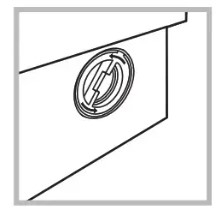
- clean the inside thoroughly
- screw the lid back on;
- reposition the panel, making sure the hooks are securely in place before you push them onto the appliance.
Checking the water inlet hose
Check the inlet hose at least once a year. If there are any cracks, it should be replaced immediately: during the wash cycles, water pressure is very strong and a cracked hose could easily split open. Never use second-hand hoses.
Troubleshooting
Your washing machine could fail to work. Before contacting the Technical Assistance Centre (see “Assistance”), make sure that the problem can be not solved easily using the following list.
| Problem: | Possible causes / Solutions: |
| The washing machine does not switch on. |
|
| The wash cycle does not start. |
|
| The washing machine does not take in water (the indicator light for the first wash cycle stage flashes rapidly). |
|
| The washing machine continuously takes in and drains water. |
|
| The washing machine does not drain or spin. |
|
| The washing machine vibrates a lot during the spin cycle. |
|
| The washing machine leaks. |
|
| The START/PAUSE indicator light (orange) and the function indicator lights flash rapidly. |
|
| There is too much foam. |
|
Service
Before calling for Assistance:
- Check whether you can solve the problem alone (see “Troubleshooting”);
- Restart the program to check whether the problem has been solved;
- If this is not the case, contact an authorized Technical Assistance Centre using the telephone number provided on the guarantee certificate.
! Always request the assistance of authorized technicians.
Have the following information to hand:
- the type of problem;
- the appliance model (Mod.);
- the serial number (S/N).
This information can be found on the data plate applied to the rear of the washing machine, and can also be found on the front of the appliance by opening the door.
FAQs about Hotpoint Washing Machine
My Hotpoint washing machine is stopping mid cycle
We recommend you check that your cold water supply is on. This is a common cause of your appliance failing to fill on the ‘rinse’ cycle and will result in your Hotpoint washing machine stopping mid-cycle.
My Hotpoint washing machine will not spin
Your Hotpoint washing machine has an in-built feature to prevent it from spinning with an unbalanced load. The appliance will try to redistribute the load to achieve balance, however, if it remains unstable the spin process will be aborted. This will minimize excessive vibration and prolong the life of your machine.
My Hotpoint washing machine appears to have no electrical supply
Check that the socket your Hotpoint washing machine is connected to is live by plugging in and testing another piece of equipment such as a radio. Your Hotpoint washing machine comes fitted with a 13 amp plug and lead, please ensure that the correct rating of fuse is being used.
Can I stack my Hotpoint tumble dryer onto my washing machine?
Hotpoint tumble dryers are designed to be fitted onto the top of some of our Hotpoint washing machines. This stacking process must only be completed using one of our genuine stacking kits.
Why are my wash results poor?
To achieve the perfect wash make sure you select the correct program, and then add the recommended amount of detergent. Take care not to overload your Hotpoint washing machine as this will produce poor wash results due to an inability of the appliance to effectively dissolve the detergent. Try re-washing garments on the correct program ensuring that an adequate amount of detergent is used.
My Hotpoint washing machine is taking too long?
Modern washing machines are designed to use less water, which means the appliance launders the clothes more – resulting in longer wash cycles.
My Hotpoint washing machine is leaking
As part of the manufacturing process, we thoroughly test your washing machine to ensure that it will not leak from any internal components after you have installed it.
Any leaking before or during its first use is most likely due to water still remaining in the washing machine following this testing process.
My Hotpoint washing machine is noisy and unstable.
If your Hotpoint washing machine appears noisy or unstable when using it for the first time it’s possible the installation has not been completed properly.
Please ensure the protective brackets or bolts (used for transportation) have all been removed before using your washing machine. You can keep them should you wish to transport your appliance again in the future.
My Hotpoint washing machine appears to have no electrical supply.
Check that the socket your Hotpoint washing machine is connected to is live by plugging in and testing another piece of equipment such as a radio.
Your Hotpoint washing machine comes fitted with a 13 amp plug and lead, please ensure that the correct rating of fuse is being used.
For more manuals by Hotpoint, visit Manualsdock
Hotpoint Washing Machine instruction manual
[embeddoc url=”https://manualsdock.com/wp-content/uploads/2023/07/Hotpoint-Washing-Machine.pdf” download=”all”]

